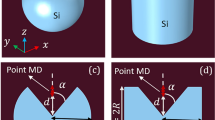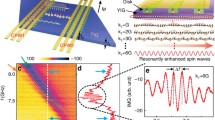Abstract
Methods, equations, and software tools for designing iron-core dipole magnets, developed by the accelerator physics community but not well known in the compact NMR community, are introduced here. Many of these tools are due to Klaus Halbach, including the equations accounting for the “excess flux” at the edges of the poles and the software for calculating the fields throughout the magnet structure. The advantages of using magnetic ink for passive shimming of compact magnets are discussed, and the details of the implementation of ink-based shims are presented. Examples of combining ink shimming with space-efficient high-order active shims in compact magnets demonstrate the possibilities of iron-core dipole magnets as platforms for inexpensive, manufacturable NMR-based device development.










Similar content being viewed by others
Availability of Data and Materials
Not applicable.
References
G. Morris, Varian associates and the birth of commercial NMR spectroscopy. J. Magn. Reson 306, 12–19 (2019)
R. Freeman, G. Morris, The Varian story. J. Magn. Reson. 250, 80–84 (2015)
See, for example, C. E. News 45, 22–23 (1967).
R.H. Krauss, An overview and history of permanent magnet devices in accelerator technology. IEEE Trans. Magn. 30, 1547–1554 (1994)
K. Halbach, Design of permanent multipole magnets with oriented rare earth cobalt material. Nucl. Inst. Methods 169, 1–10 (1980)
A.W. Obst, N.S.P. King, A.D. Hancock, R.A. Hilko et al., A compact permanent magnet spectrometer. Nucl. Inst. Methods Phys. Res. A 263, 407–413 (1988)
A.F. McDowell, M.S. Conradi, Thin high-order shims for small dipole magnets. J. Magn. Reson. 281, 7–16 (2017)
A.F. McDowell, “Magnetic Field Correction System,” US Patent 9285441 (2016).
A.F. McDowell, Adjustable passive shims for dipole NMR magnets. J. Magn. Reson. 296, 143–151 (2018)
A.F. McDowell, “Extended Continuous Passive Shimming of Magnets,” US Patent 10739428 (2020).
A.F. McDowell, “Continuously Adjustable Passive Shims,” US Patent 10845441 (2020).
B. C. Brown, “Design formulas for the strength, compensation and trimming of hybrid permanent magnets,” FERMILAB/Conf-96/273 (1996).
J. Tanabe, “Iron dominated electromagnets: Design, Fabrication, Assembly, and Measurements,” SLAC-R-754 (2005).
K. Halbach, Applications of permanent magnets in accelerators and electron storage rings. J. Appl. Phys. 57, 3605–3608 (1985)
G. Jackson, ed., “FermiLab Recycler Ring Technical Design Report,” FermiLab-TM-1981 (1996).
M. Hu, “The FermiLab Recycler Ring,” Proc. 2001 Part. Accel. Conf., Chicago (2001).
J.T. Volk, Experiences with permanent magnets at the FermiLab Recycler Ring. J. Instrum. 6, T08003 (2011)
B.J.A. Sheppard, “Permanent magnets for accelerators,” 11th Int. Part. Acc. Conf. , 2020.
S. Brooks, G. Mahler, J. Cintorino, J. Tuozzolo, R. Mich, Permanent magnets for the return loop of the Cornell-Brookhaven energy recovery linac test accelerator. Phys. Rev. Accel. Beams 23, 112401 (2020)
K. Halbach, R.F. Holsinger, SUPERFISH—a computer program for evaluation of RF cavities with cylindrical symmetry. Part. Accel. 7, 213–222 (1976)
J.L. Warren, G.P. Boicourt, M.T. Menzel, G.W. Rodenz, M.C. Vasquez, Revision of and documentation for the standard version of the Poisson group codes. IEEE Trans. Nucl. Sci. 32, 2870–2872 (1985)
Contact Mcdowell@NuevoMR.com or Bob.Lown@gmail.com. In the past, the code was available at laacg.lanl.gov.
M.E. Rose, Magnet field corrections in the cyclotron. Phys. Rev. 53, 715–719 (1938)
T. Planche, P.M. Jung, S. Saminathan, R. Baartman, Conformal mapping approach to dipole shim design. Nucl. Inst. Meth. 925, 101–105 (2019)
J.D. Jackson, Classical Electrodynamics, 2nd edn. (John Wiley, New York, 1975), p.198
R.M. Bozorth, Ferromagnetism (IEEE Press, New York, 1978), p.348
B. Dorri and M. E. Vermilyea, “Method of optimizing passive shim placement in magnetic resonance magnets”, US Patent 5045794 (1991).
C. Hugon, M. S. Poole, T. S. Ralston, “Methods and apparatus for magnetic field shimming” US Patent 10145913 (2018).
A. Jesmanowicz, V. Roopchansingh, R. W. Cox, P. Starewicz, W. F. B. Punchard, and J. S. Hyde, "Local Ferroshims Using Office Copier Toner," 9th ISMRM, Glasgow, April 21–27 (2001), p. 617.
A. Jesmanowicz, J. S. Hyde, W. F. B. Punchard, P. M. Starewicz, “Method for shimming a static magnetic field in a local MRI coil,” US Patent 6294972B1, (2001).
W.A. Anderson, Electrical current shims for correcting magnetic fields, Rev. Sci. Inst. 32, 241–250 (1961)
Acknowledgements
The authors thank Robert Mercurio (SABR, LLC) for many years of collaboration in constructing and adjusting magnets. We also thank Bernhard Blümich for his many years of championing compact permanent magnet magnetic resonance as a stand-alone research field and establishing the meetings that are so important to the workers in this arena. RRL thanks Klaus Halbach, Ronald Holsinger, and Robert Gluckstern for sharing their insights and personal notes concerning permanent magnet design.
Funding
Neither author received external funding to support this work.
Author information
Authors and Affiliations
Contributions
AFM wrote the main manuscript, with RRL guiding the magnet design section. Both authors contributed to figures and literature searches, and both authors reviewed the article in final form.
Corresponding author
Ethics declarations
Ethical Approval
Not applicable.
Competing Interests
Both authors offer consulting services in the topic area of this article.
Additional information
Publisher's Note
Springer Nature remains neutral with regard to jurisdictional claims in published maps and institutional affiliations.
Appendix: Using Period-Correct Software
Appendix: Using Period-Correct Software
As stated in the main article, we make use of period-correct software developed in the 1960s and 1970s. This code, developed by Ron Holsinger with theoretical assistance from Halbach [20, 21], addressed a wide range of topics in accelerator physics. We are interested in the module PANDIRA which handles permanent magnet materials, as well as some supporting modules for plotting and producing output files. (For many decades, the POISSON/SUPERFISH code has been available for Windows via the Accelerator Code Group at Los Alamos National Laboratory, which maintained the code and made it available as a public service. At the time of the writing of this article, it appears to be unavailable at the LANL website. Interested readers should contact the authors for a copy of the software [22].) The documentation, while voluminous, is fragmented and suffers from poor version control. That said, support for those seeking to learn to use the code is available, the code runs quickly, we (as well as many others) have found it accurate, and it requires no fees. Here, we give a basic introduction to using the code and describe the workflow.
By far the best way to learn PANDIRA is via examples. A detailed narrative of how to run the code is provided by Tanabe [13], especially in his chapter 6. The magnet structure to be calculated is specified in a text file defining the physical regions of the 2D magnet design and the materials therein. In most cases, only one quadrant of the magnet structure is defined with the rest determined by symmetry through the specification of appropriate boundary conditions. A facile method for producing this text file is via a spreadsheet program, as detailed by Tanabe. This allows for easy modification to the magnet structure as one searches for the optimal design or responds to evolving user requirements.
Once the text file is established, a mesh on which the problem will be solved is created by running the module AUTOMESH. If the extension of the text file is “.am”, double clicking on the file will automatically invoke AUTOMESH, which then creates an intermediate file with the extensions “.T35” (which originally referenced a tape drive). At this point, opening the T35 file will display the magnet structure and (optionally) the mesh to be used. Now running PANDIRA on the T35 file (e.g., using a right mouse click) will calculate the solution and add it to the T35 file. Opening the T35 file again will show the field lines (see Fig. 3 for an example), and moving the mouse cursor to locations of interest will reveal the local values of the magnetic field and other parameters. Plots and text files containing the field values on user-specified lines or grids may be produced via the module INTERPOLATE. The user interface for this code is decidedly old-fashioned. However, once the production of the problem-defining text file is mastered, the calculations flow quickly.
In specifying the materials in the text file, one can choose between a few included types of low-carbon steel. User specified materials are also supported. The magnet material is specified by defining the values of \({B}_{cept}\) and \({H}_{cept}\) These parameters are the Y and X intercepts of the linearized \(B-H\) curve (see Fig. 4). \({B}_{cept}\) is the remanent magnetization \({B}_{r}\). \({H}_{cept}\) is used by PANDIRA to calculate the value of \(\mu\), so \({H}_{cept}\) will be slightly larger in magnitude than the \({H}_{c}\) specified by the manufacturer. \(\mu \approx 1.05\) for most magnet materials. The orientation of each magnet block is specified by the parameter \({a}_{easy}\), the orientation of the easy axis of magnetization for that piece.
With a PANDIRA calculation result displayed, it is easy to check the field strength at various points by moving the mouse cursor to the location of interest. The most critical regions to inspect are discussed in the main article.
When setting the yoke and return thicknesses to limit the field strength to 10 kG, one needs to keep in mind that the PANDIRA model is axisymmetric. If the actual magnet will have lower symmetry, then the limit of the field strength calculated for the steel may need to be lowered by an amount given by the ratio of the flux-carrying areas of steel in the PANDIRA model and the actual magnet structure. In general, equivalence of areas is the most important guiding principle in matching the PANDIRA model to the actual magnet, for example in modeling the square-poled box magnet in Fig. 1. The impact of the actual magnet’s lack of structural symmetry on the magnet field in the gap, both strength and homogeneity, will be surprisingly weak.
When checking the homogeneity in the PANDIRA model, it may be helpful to use the INTERPOLATE module to calculate the field along the midplane of the magnet. This is useful for dialing in the Rose ring dimensions.
Rights and permissions
Springer Nature or its licensor (e.g. a society or other partner) holds exclusive rights to this article under a publishing agreement with the author(s) or other rightsholder(s); author self-archiving of the accepted manuscript version of this article is solely governed by the terms of such publishing agreement and applicable law.
About this article
Cite this article
McDowell, A.F., Lown, R.R. Designing and Shimming Compact Iron-Core Dipole Magnets for NMR Spectroscopy. Appl Magn Reson 54, 1663–1687 (2023). https://doi.org/10.1007/s00723-023-01572-5
Received:
Revised:
Accepted:
Published:
Issue Date:
DOI: https://doi.org/10.1007/s00723-023-01572-5




